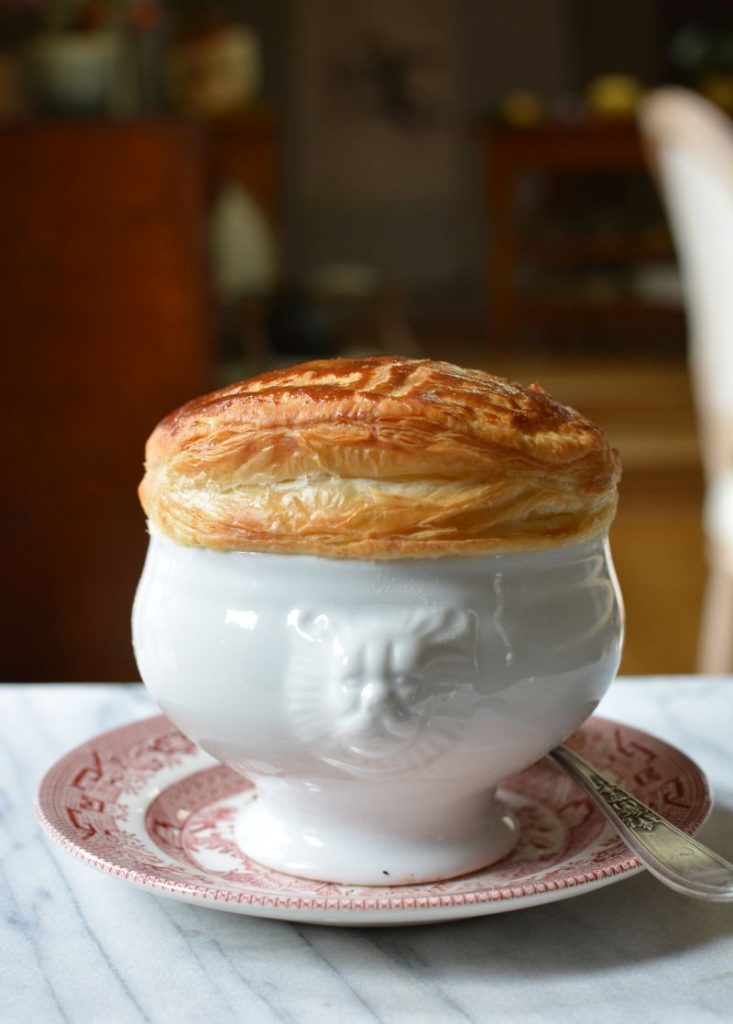
"If you want to impress jaded Vietnamese guests, make French food,” my mom frequently told me while I was growing up. That’s among the reasons she made puff pastry when we came to the United States. It was as if she had been waiting all her life to knead excess moisture out of butter to create the laminated dough known as pate feuilletée. She once folded up a piece of paper to show us kids the potential number of layers created in the classic French pastry dough that magically puffed in the oven.
That’s how I grew up in San Clemente, California. Mom’s rotation included Vietnamese classics like charcuterie, pho, and sticky rice, plus puff pastry. What did she do with all that dough? She mostly made pate chaud, small, round meat-filled pastry that we at as a Viet-Franco breakfast snack.
Starting in the late 1970s and into the early 1990s, my dad’s friend, Mr. Lap Trung Huynh, opened a string of very successful and notable French restaurants in the Bay Area, Santa Barbara, Santa Monica, and Irvine. His establishments were the first by a Vietnamese-American to attract serious media attention. He'd owned a restaurant in Saigon. Mr. Lap occasionally visited to catch up with my parents and trade cooking tips with my mom.
He was a bit of a hustler, and he claimed that he had trained with Paul Bocuse and Roger Verge, two of the most influential French chefs of the 20th century. My understanding is that he’d attended some casual demos with the chefs. Mr. Lap was charming and highly entrepreneurial. His hardworking wife, children, and extended family worked in their restaurants.
It was through Mr. Lap’s loose association with Bocuse that my parents knew of the French chef from Lyon, one of France’s biggest cities and renowned for its excellent cuisine Lyonnaise, which includes a sinfully rich onion soup that involves port and egg yolks. One day, while shopping at Crown Books, a discount bookstore chain, my dad and I came across Bocuse’s French Cooking (Random House, 1977). We bought the hardcover tome to gift my mom.
After paging through the book, my mom decided that she wanted to tackle Bocuse’s signature truffle soup under a puff pastry dome. Bocuse wrote that he’d first made the soup for French president Valéry Giscard d'Estaing (V.G.E. to the French). Undaunted, my mom prepared it, finding a new use for her homemade puff pastry. (She later went on to make Bocuse’s fish under puff pastry, onion soup, and candied chestnuts.)
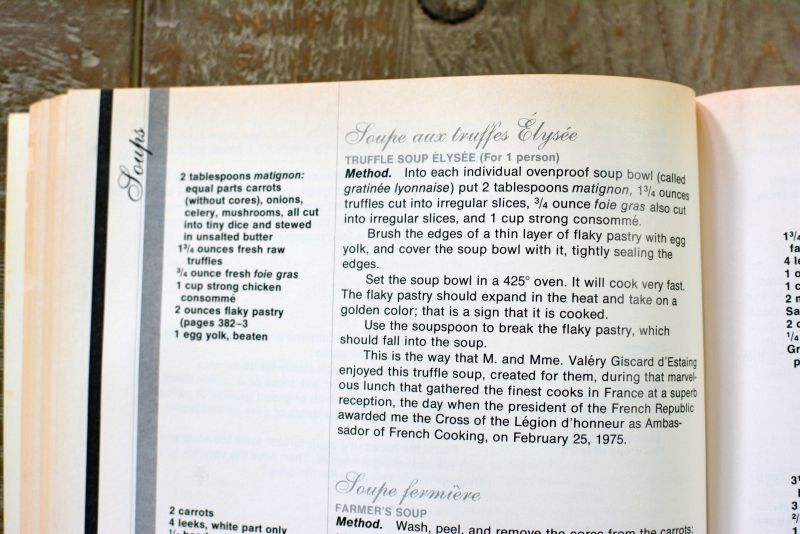
Bocuse’s recipes in that book are relatively vague. He expected cooks to have a rigorous sense of cooking and ability to finesse. My mom fit the bill. She deployed her gingery homemade chicken stock as a stand in for his strong chicken consommé. Lacking truffles, she used shiitake mushroom. No big deal that we didn’t have foie gras. She used chicken liver. Her version was a scrappy Viet refugee take on Bocuse’s Soupe au Truffles Élysée.
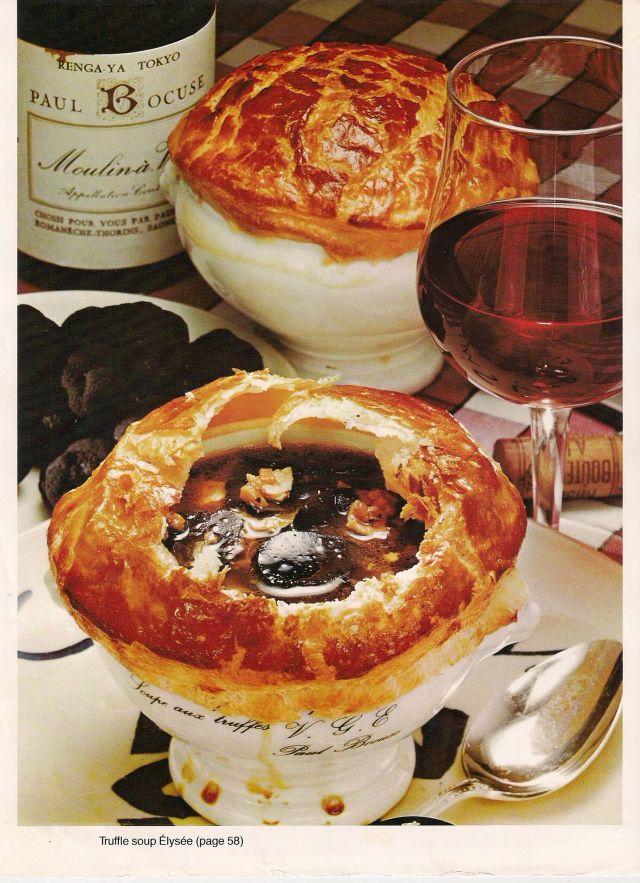
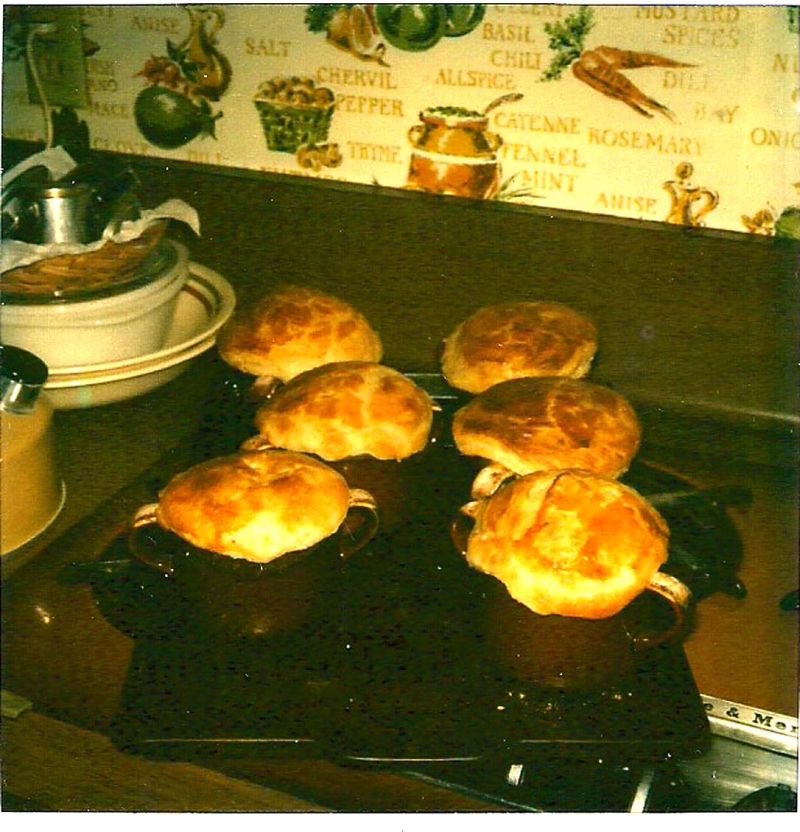
My dad found our ceramic soup bowls at the Akron, a precursor to Cost Plus. The homemade puff pastry baked into a chapeau (hat) of sorts. We’d never had truffles and foie, and were entranced with the perfume, flavor and texture of the simple components. The soup was delicious.
When my mom felt confident, she started making Bocuse’s soup for special Viet dinner guests. She’d get us kids into an assembly line to put the soup together and wait patiently for the bake to finish. Then, we carried each soup to the table. She and my dad would pull out Bocuse’s cookbook to explain how our guests were being treated like VGE. Everyone would marvel and giggle with delight as they dug in with gusto.
French colonialism in Vietnam had its good and bad. When it came to food, Viet people have never shied away from making a French recipe their own.
My dad got into the soup so much that he sought out bottles of Moulin-a-Vent to match Bocuse’s photo from the book (above). He’d first tasted the Beaujolais in 1957. A friend had recommended the red wine, which was then sold at Thai Thach, a store in Saigon that sold French gourmet products. To try it out, my dad served it to a Frenchman who came for lunch. I was Lent so the menu was meatless: a superb omelet and bottle of Moulin-a-Vent. The Frenchman approved, Dad recounted.
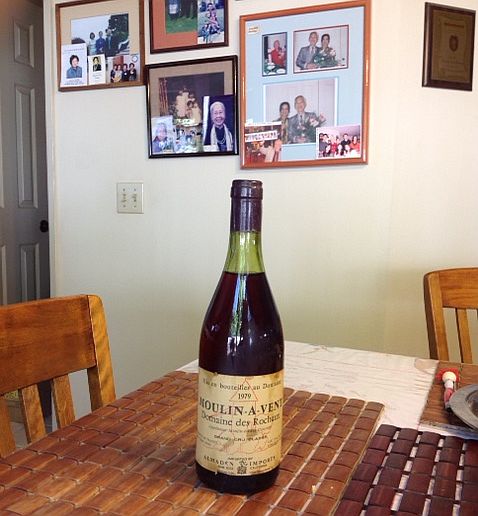
After Trader Joe’s opened in Orange County in the early 1980s, my dad and I would frequently prowl the aisles. The day he spied 1979 Moulin-a-Vent, he bought a few bottles. Last weekend, he revealed that he still had one (above!).
“You should have the wine as a keepsake,” Dad emailed. I’d just sent him Bocuse’s obituary by William Grimes in the New York Times. Early in the article, Grimes mentioned THE soup and then he went on to discuss Bocuse’s flair for self-promotion and matter-of-fact personality (he had a wife and two mistresses). The man was a talented, driven showman.
My father has been dealing with health issues, but thinking of Bocuse and that soup energized him. Between emails and phone calls, Dad, Mom, and I flooded ourselves with fond memories of our family’s soup project.
“We had an unusual relationship with Bocuse through that soup,” my mother said. “I made it for years to wow people! I dissected his instructions carefully. Once in a while, the pastry would drop into the soup and I’d be so embarrassed.” The broth needs to be the right temperature, or the pastry will collapse. That's to say, the broth shouldn't be hot.
With a paperback version of Bocuse's book, and stories and memories from my parents, I tackled the soup this week. I had a few advantages over my mom. For example, I was able to quickly make a chicken consomme/stock in the multicooker (40 minutes at high pressure!). Chicken feet added body to the brew, and I used ginger and cilantro to mimic why my mom made. The result is an East-West chicken stock recipe!
There was no truffle around, so I used truffle butter and soaked some shiitake to add texture and earthiness to the vegetable mixture. I found out that there’s no need to heat up the stock before assembling the bowls.
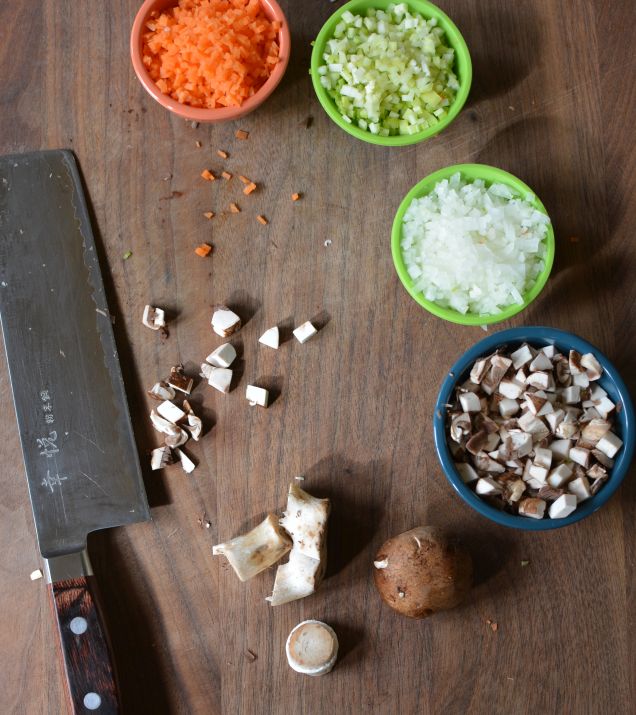
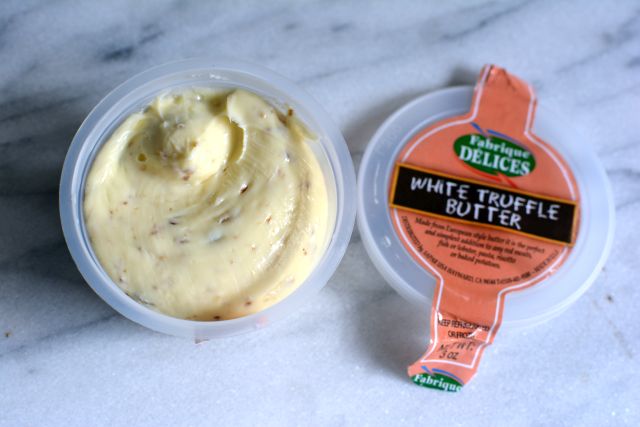
I also discovered an updated versions of Bocuse’s soup that included Noilly Prat vermouth and cooked chicken or beef. The liver was still in the recipe but the chicken I used didn’t have one and since foie is about rich fattiness, I used a generous amount of European-style butter to cook the vegetables.
Did I made puff pastry? No way. I bought it. (My mom expressed a certain degree of disappointment when I revealed that I’d used store-bought.)
If you’re unfamiliar with puff pastry, start with Pepperidge Farm brand. It is not made with butter (it’s vegan, actually) but it’s super easy to work with, affordable, and available at regular supermarkets. Or, go whole hog with all-butter puff pastry sold at Whole Foods and other specialty markets.
Homemade stock or consommé (clarified stock) is fabulous, but you could do test runs with Swanson’s low-sodium chicken broth or Whole Foods regular chicken broth. They have similar sodium levels and taste chicken-y.
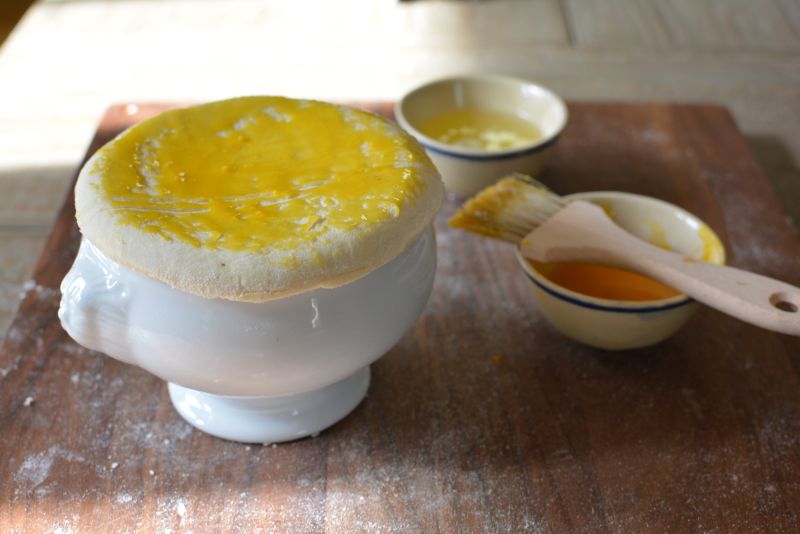
I initially made the soup for myself at lunch. It was so easy and fun that I made it again for dinner to serve my husband. The last time I had Bocuse’s truffle soup was in the mid-1980s, when I was in high school. It’s still excellent.
It’s incredibly fun to break the pastry to release the aroma of the truffle and soup underneath. The pastry soaks up the soup and becomes like a rich noodle. This recipe is not hard, either. Bocuse was a master at elevating simple French home cooking.
My main struggle was with finding soup bowls. The ones I got have the classic French lion’s head design, which is iconic with Lyon, where Bocuse was born; he was known as the “Lion of Lyon”. But as he suggests in the recipe, French onion soup bowls (gratinee lyonnaise) will do. I like these, which are made in France. The bowls should be roughly 14-ounce capacity. A round rim (no little ears at the edge) helps to secure the pastry in place. You could use rice or cereal bowls.
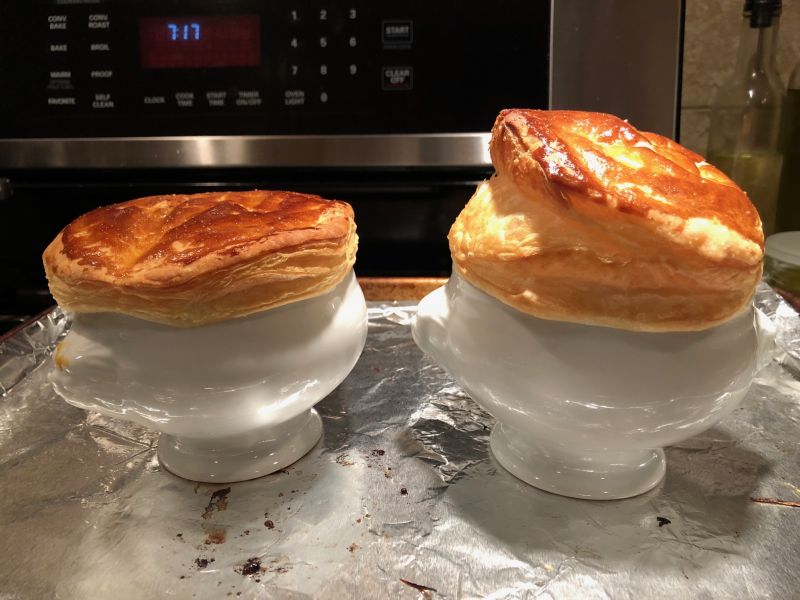
Potential tweaks: For a vegetarian take, use homemade vegetable stock. If you want to go vegan, cook the vegetables in a mellow, rich olive oil and use truffle oil. I was also thinking that pho broth and pho fat would be awesome, too. There’s a lot of leeway with this recipe because it’s just broth with rich, fatty bits under a dome of puff pastry. It's totally doable. Seriously.
For my parents', wowing their generation meant presenting shock-and-awe dishes like this one. For me, this simple, elegant, and fun soup is about connecting with my family and good times. I hope this recipe opens up similar opportunities.
Paul Bocuse's Soup with Truffle
Yield 4 Servings
For a light lunch, serve with a salad. It's a great starter for a special dinner, too!
Ingredients
- 2 tablespoons unsalted European-style butter
- ¼ cup finely diced carrot (omit the core)
- ¼ cup finely diced celery stalks or celery root
- ¼ cup finely diced onion
- ⅓ cup diced fresh cremini, white, or shiitake mushroom
- 1 tablespoon mushroom soaking liquid
- 2 dried shiitake mushroom, rehydrated in ¼ to ⅓ cup water, stems discarded, then thinly sliced into small pieces
- 1 ½ to 2 tablespoons truffle butter
- 1 (8 to 9-ounce) sheet puff pastry, rolled out to ⅛ inch thick
- 3 to 3 ½ cups East-West Chicken Stock or homemade chicken stock or vegetable stock, at lukewarm temperature
- 1 egg white, beaten
- 1 egg yolk, beaten with ¼ teaspoon water
Instructions
- Put the butter, carrot, celery, onion, mushroom and mushroom soaking liquid in a small saucepan. Set over medium-low heat. When heated through, lower the heat to about low. Cook, stirring, for about 5 minutes, until the vegetables are soft and earthy with fragrance. There should be little liquid visible. Set aside to cool. You’ll have about ⅔ cup. Refrigerate up to several days.
- To make the soup, preheat the oven to 425F. Use four 14 to 16-ounce oven-proof bowls, such as ones for French onion soup or cereal bowls. Cut the pastry into four circles, each about ¼ inch wider than the rim of the bowl. You may have to gently roll the pastry out a little wider. You don’t have to be perfect with the circles. Set aside or cover and refrigerate for hours or overnight.
- In each bowl, put 2 generous tablespoons of the vegetable mixture, some sliced mushroom, and 1 to 1 ½ teaspoons truffle butter. Divide the consommé (stock or broth) between the bowls. Add pinches of salt and pepper to each bowl.
- If the bowl’s rim is about ¼ inch thick, brush egg white on it. Otherwise, paint the rim of each pastry circle with egg white; a ½-inch border works. Place the pastry on the soup bowl, then use your hands to press down on the edge to secure in place. The pastry will naturally stretch over the rim. It will bow in the center of the bowl. It’s strong stuff so don’t worry. Brush the top with egg yolk.
- Place the soup bowls on a baking sheet. Bake for about 15 minutes, until the tops have puffed up and are richly browned. Serve hot. Tell guests to use their spoons to forcefully break through the pastry, which will fall into the soup and become a rich noodle of sort. Bon appetit!
Courses Lunch or dinner
Cuisine French













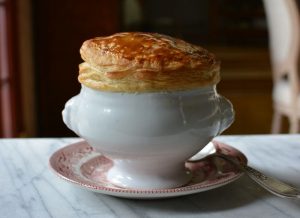




Laura M says
I loved reading this story about your family and its connection with Paul Bocuse. One of my favorite lines was the description of your mother's version of the soup as "...a scrappy Viet refugee take ..." I can imagine how proud your parents must have felt serving such an elegant, delicious soup to their guests. Now I need to make this! Thank you for sharing such a nice memory.
Andrea Nguyen says
My family stories are unusual and well, explain who I am. I didn't realize what my mom had done to make Bocuse's recipe doable in our humble home. It wasn't till the other day when we chatted that I realized her determination with this recipe. For me as a teenager, the soup just tasted good. Plus, we had fun.
Gina Bisaillon says
What a beautiful story!
My partner and I were at Bocuse's restaurant in Lyon back in the '70s. We had ordered a bottle of the local Cornas wine, and when we expressed surprise that it was served cold, Mr. Bocuse himself came to our table to explain why this was so. We mentioned that we had a French restaurant in Canada, so we had quite a chat and he confided that he had just discovered that the microwave oven was perfect for finishing the salmon.
Andrea Nguyen says
Gina -- that's so incredibly wonderful! Love how you challenged Bocuse and ended up having such a congenial conversation. He was such an interesting man. Down to earth. I have a close friend who was born in Lyon. He's a chef and has a personality similar to Mr. Bocuse! Thank you for sharing.
Molly B says
Wonderful post! I really enjoyed reading this. And the soup sounds great! I'm inspired to hunt down some puff pastry and try the soup this weekend.
Andrea Nguyen says
You totally can make this soup. Admittedly, I had some trepidation because there seemed to be many moving parts and fussy ingredients. But you know what? It's simple cooking. Try it out with Pepperidge Farms pastry. It's what I used here. Seriously. Thanks for commenting!
Gregory P Dendler says
I'll make it this weekend. I've got some leftover chicken pho broth that should work nicely.
Andrea Nguyen says
Awesome, Greg! Let me know how it comes out!
JoAnn Janjigian says
Your story about the Truffle Soup and the cooking and reproduction of a recipe by both you and your Mom are inspiring! Thank you for sharing.
Andrea Nguyen says
My pleasure. Would you happen to be related to Andrew of MSG popcorn fame? If you are, it's awesome to e-meet you!
Caelen says
Salutations.
I am wondering, for this recipe, if there is something else you could brush on the rim of the bowl and on top of the pastry that is vegan-friendly. Would vegan butter work ?
Please let me know if you have any ideas.
Andrea Nguyen says
Of course, you can try that. It wouldn't hurt.